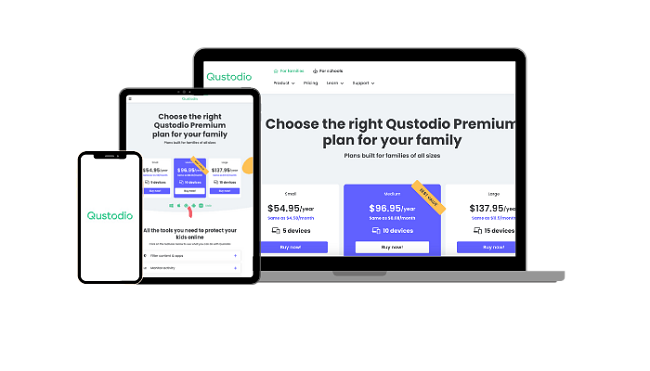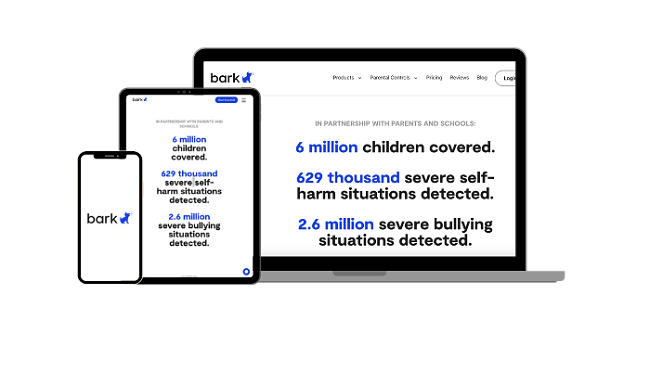How to Block Google Play Purchases in 2024
I noticed charges on my credit card statement for Google apps that I didn’t buy. After a bit of investigating I saw that one of my kids was buying apps without my knowledge. I quickly adjusted the setting in the Play Store app to require authentication before every purchase.
This was a good first step, but unfortunately it’s not good enough by itself. It’s not that difficult for a child to change the Play settings or get the app another way. This situation reminded me that I don’t really know what my kids are doing on their phones.
While searching for a solution, I tested over 30 parental control apps. I only found 3 that had the tools I needed to block Play purchases and monitor what they do on their phones. Qustodio stood out as the best overall option. It blocks apps and websites, lists all apps installed on the phone, and has detailed activity reports.
Try Qustodio free for 30 days!
Quick Guide: Block Purchases on Google Play
- Open Google Play privacy setting: Open the Play Store app on your child’s device, tap on their profile picture to find the privacy settings.
- Adjust Google Play settings: Enable the authentication feature to prevent any unauthorized purchases from their devices. However, it’s worth noting that this solution alone can be relatively easy for kids to bypass.
- Install a parental control app: This is a more comprehensive solution that can block the Play Store and provide an updated list of apps installed on the device. After rigorous testing, Qustodio proved to be the best option. Try it free for 30 days!
First Steps: How to Block Google Play Purchases in 2024
Important: The settings below only prevents Play purchases from your child’s phone, tablet, or computer. They won’t block other app store purchases, APK downloads, or installing pirated apps. You need a parental control app to block all unwanted app purchases and downloads.
The Google Play Store has the option to enable authentication for all purchases. Once this feature is enabled, your child won’t be able to purchase apps, movies, songs, books, or Google products on their devices without authorization.
To get started:
- Open the Play Store app on your child’s device.
- Click on the profile picture or avatar on the top right corner.
- Tap Settings.
- Open the Authentication Settings.
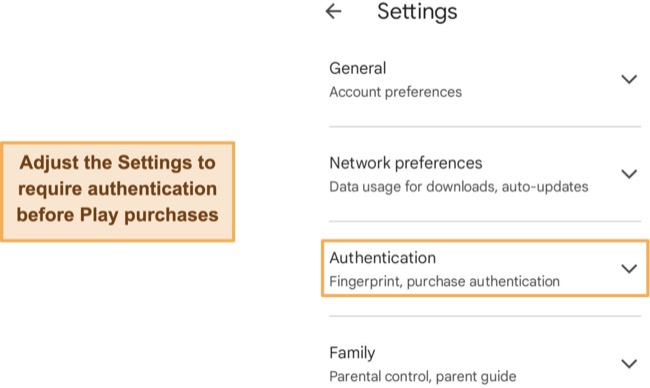
There are two authentication methods for preventing unauthorized purchases; biometric and password.
Enable Biometric Authentication
The first option is to require biometric authentication, such as facial recognition or a fingerprint. I found it interesting that I needed my Google password to enable this feature but not to disable it. Another problem I saw is that when I checked it out on the Play Store, it gave the option to skip the biometric authentication and just use a password.
Your Google password is the default setting, and it’s required if the biometric option isn’t enabled. While your password should be private, it’s pretty easy for kids to figure it out especially if you use the same computer.
Customize When Authentication is Required
In addition to enabling purchase authentication, you can also choose when authentication is required. The 3 options are: every purchase, every 30 minutes, or never. The best option is to enable authentication for all purchases. Otherwise your child might trick you into purchasing one thing, and then taking the phone and making another purchase within 30 minutes.
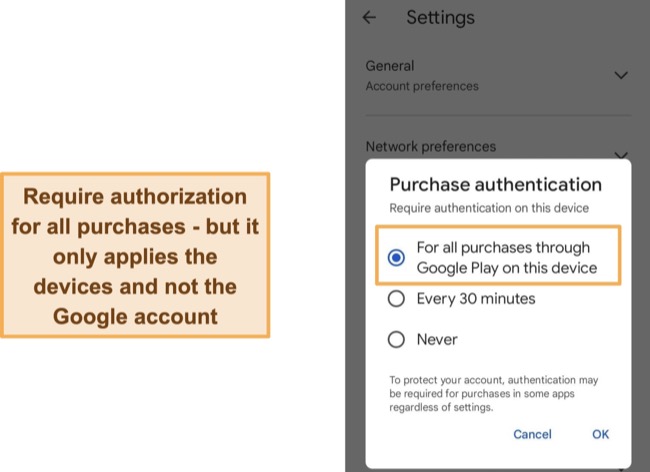
This is why adjusting Google Play settings alone may not be sufficient to block purchases because kids can still find ways to bypass it. Parental control apps offer a more comprehensive solution by providing additional layers of protection and monitoring to ensure a higher level of security and oversight.
3 Best Parental Control Apps for Blocking Google Play Purchases in 2024
1. Qustodio: Blocks Google Play, 3rd Party App Stores, and Download Sites
- Blocks access to Play Store to prevent unauthorized purchases.
- Includes lists of all apps installed on the device.
- Activity report details app use, browser history, and web searches.
- Web filter blocks download sites.
- Comes with a 30 day free trial.
Qustodio proved to be a comprehensive parental control app. The installation and setup were very easy, and it’s the only instance where you need physical access to the child’s phone or tablet. All of the parental control rules and monitoring features are managed from the cloud-based parental dashboard.
Qustodio can block the Play Store app from opening, which effectively blocks all purchases. Open the Apps and Games section in the dashboard and toggle the selector to the left to prevent it from opening.
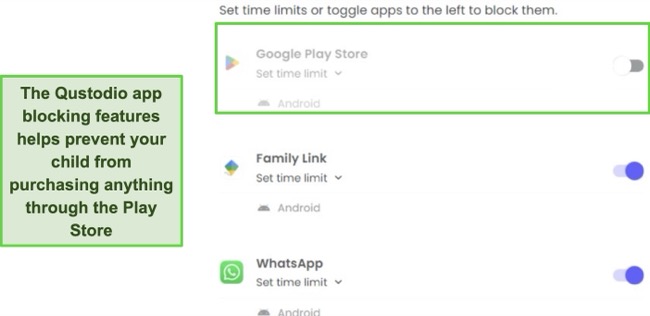
Another option, if blocking the app isn’t the right solution for you, is to set screen time limits on the Play Store. When you do this, your kids won’t need to ask you to unlock the Play Store whenever they want to download an app. Instead, you can limit when the app is available, ensuring that you’re around when it’s unlocked and you can monitor their downloads.
One more thing to remember is that while the Play Store might be the biggest app store for Android, it’s not the only one. With Qustodio, you can block these other stores to prevent unwanted purchases by following the same steps used above. If your child is buying apps on a website, you can add the URL to the web filter blacklist to prevent them from opening.
You can monitor what apps your child downloads and uses through the multiple reporting tools. The dashboard homepage shows the top 5 apps, based on time spent using the app. You can see a complete list of apps your child uses in the Apps and Games section of the dashboard. The Activity Timeline is a chronological list of app use, search terms, browser history, and more.
In addition to these features, Qustodio has the best free trial offer I’ve seen. You can try Qustodio free for 30 days, and you don’t need a credit card to activate the account. It will give you access to all the premium features, so you can test Qustodio yourself and see if it’s a good fit for your needs.
2. Bark: Customizes When The Play Store is Accessible to Prevent Unwanted Purchases
- Powerful filter can block all app store apps.
- Blocks specific URLs, such as web-based Play Store.
- Sends alerts after app installations.
- Includes a 7-day free trial!
Bark is a different type of parental control app than Qustodio. Its main focus is monitoring social media for inappropriate activity. That being said, I was surprised at how it can help you prevent unwanted purchases on the Play Store, and other app stores and websites.
The web and app filter in Bark’s screen time settings allows you to set four different rule sets based on the time of day: School, Free Time, Bedtime, and Default. Each set lets you choose specific apps or app categories to disable. One of the options is to block App Stores & System Updates, restricting downloads and updates during the rule’s active period.
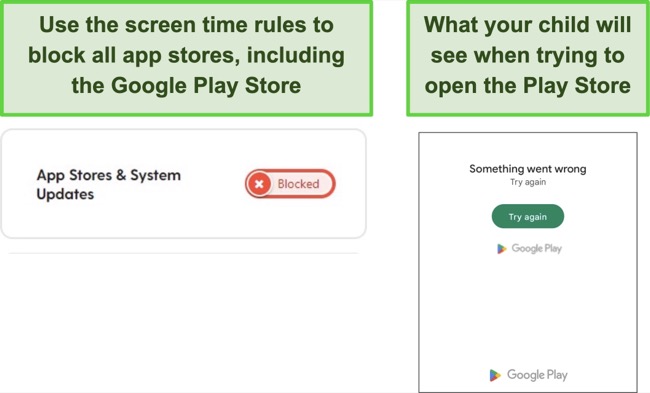
After you set the rules for each time segment, you can customize when to enforce each set of rules. The names of the segments are just suggestions, you can enable them for any time. The advantage of this system is that you can block the Play Store during the day, and only make it available when you are home to monitor your child.
The Bark web filter gives you the option to set up a list of blocked websites. During my testing I saw that even though I blocked App Stores, it only affected apps, not websites. To fix this loophole, go to the web filter and block the Play Store website. This is another way to prevent unwanted Google Play Store purchases.
You can view reports in the Insights section of your Bark dashboard. There is a section that lists all of the newly installed apps. Use this information to double check and make sure that your child didn’t log in to the Play Store from a different device to buy and install apps. You’ll also see alerts if there is an attempt to access the Play Store while it’s blocked.
In addition to blocking and reporting on Play Store usage, Bark monitors over 30 social media networks, messenger, and email apps. There is a 7-day free trial, so you can see if Bark works for you as well as it worked for me.
3. Norton Family: Monitors installed Apps So Your Child Can’t Install Apps Without Your Knowledge
- Create custom rules and block any app and website.
- Use the School Time feature to block Play Store at specific times.
- Try it free for 30 days!
The Norton Family parental control app is more than just an add-on to the popular antivirus software. I’ve tested it several times over the past few years, and have seen a lot of improvement in its features and how it works. The installation was quick and the dashboard has an easy-to-use interface, which helped me set up the parental control rules.
There is an App Management section on the dashboard that lists every app that’s installed on the phone. Find the Play Store app and move the selector to block it. If your child tries to open the Play Store, a Norton Family lock screen will let them know it’s blocked.
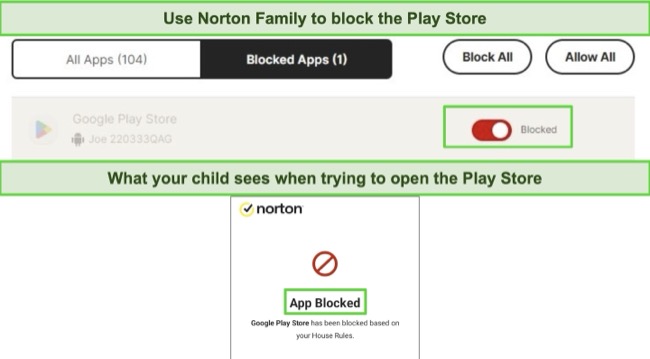
Norton Family has a School Time feature that blocks non-educational websites during school hours. You can use this to set up a schedule for when the Play Store is available. I found that this helped build trust with my child, as opposed to always blocking the app.
You can try Norton Family free for 30 days. Unlike the Qustodio trial, you will need to add a payment method to activate your account and free trial.
FAQs About Blocking Google Play Purchases
How can I block my kids from spending money at the Google Play Store?
Can I block the Play Store?
How can I see what apps my child buys or downloads?
Even with Google Play Settings, You Still Need a Parental Control App
Changing the Google Play Store settings to require authentication before every purchase is an important first step. Your child won’t be able to buy apps, books, or movies through their Google account without your PIN or biometric permission.
However, it won’t block the Play Store app or other app stores and download sites where your child can make unauthorized purchases. Therefore, you should also use a parental control app, to block these sites and monitor app install.
After testing more than 30 parental control apps, Qustodio proved to be the best option. You can block any app or website, view and manage installed apps, and monitor websites and search history to see if your child is trying to find alternative ways to buy or download these apps, books, and movies. You can try Qustodio free for 30 days and see how it works for you.

